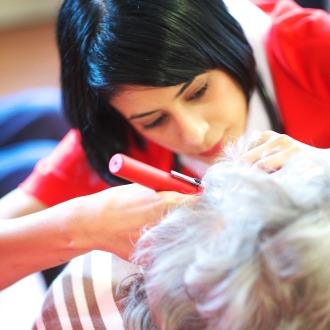Removing earwax is down to GP practices, says new NICE guideline

GP practices should provide earwax removal services rather than referring patients to specialists, according to the latest NICE recommendations.
The adult hearing loss guidelines, released today, said that if earwax is contributing to hearing loss or needs to be removed for an ear examination, practices or community clinics should provide the service rather than referring them to an ears, nose and throat specialist for the same procedure.
But the BMA’s GP Committee said this guidance ‘places no obligations on GPs to provide this service unless contracted to do so’, and suggested CCGs needed to commission the service separately.
The new NICE hearing loss guidance also recommends that GPs:
- Advise adults not to remove earwax or clean their ears by inserting small objects, such as cotton buds, into the ear canal, as this could cause damage or push the wax further into the ear;
- Refer adults with sudden onset or rapid worsening of hearing loss in one or both ears, which is not explained by external or middle ear causes;
- Immediately refer adults with acquired unilateral hearing loss and altered sensation or facial droop on the same side to an ear, nose and throat service or, if stroke is suspected, follow a local stroke referral pathway;
- Immediately refer adults with hearing loss who are immunocompromised and have otalgia (ear ache) with otorrhoea (discharge from the ear) that has not responded to treatment within 72 hours to an ear, nose and throat service;
- Consider making an urgent referral to an ear, nose and throat service for adults of Chinese or south-east Asian family origin who have hearing loss and a middle ear effusion not associated with an upper respiratory tract infection;
- Consider referring adults with hearing loss that is not explained by acute external or middle ear causes to an ear, nose and throat, audiovestibular medicine or specialist audiology service for diagnostic investigation, using a local pathway.
NICE has estimated that 2.3 million people in the UK each year have problems with earwax sufficient to need intervention.
A spokesperson said: ‘The NICE guideline aims to help improve care for people with hearing loss through better management of earwax, prompt and accurate referral of people with symptoms to the right service at the right time, and robust assessment and correct treatment.
‘It recommends that GP surgeries or community clinics should offer to remove earwax if a build-up is contributing to someone’s hearing loss. This means patients do not need to be referred to a specialist ear, nose and throat (ENT) service for the same procedure.’
They added that if a patient experiences sudden hearing loss without an obvious cause, they should be referred immediately to a specialist service or an emergency department.
However GPC clinical and prescribing policy lead Dr Andrew Green responded: ‘NICE is responsible for clinical guidance but have nothing to do with commissioning services which are the responsibility of CCGs.
‘The fact that NICE recommends something as suitable for primary care places no obligations on GPs to provide this service unless contracted to do so.’
Visit Pulse Reference for details on 140 symptoms, including easily searchable symptoms and categories, offering you a free platform to check symptoms and receive potential diagnoses during consultations.












